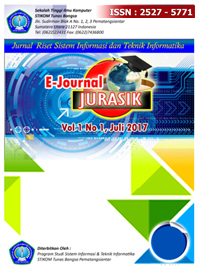Mengelompokkan Garis Kemiskinan Menurut Provinsi Menggunakan Algoritma K-Medoids
Abstract
Full Text:
PDFReferences
N. Zuhdiyaty and D. Kaluge, “Analisis Faktor-faktor yang Mempengaruhi Kemiskinan di Indonesia Selama Lima Tahun Terakhir (Studi Kasus Pada 33 Provinsi),” Jurnal Jibeka, vol. 11, no. 2, pp. 27–31, 2017.
N. Zuhdiyaty, “ANALISIS FAKTOR - FAKTOR YANG MEMPENGARUHI KEMISKINAN DI INDONESIA SELAMA LIMA TAHUN TERAKHIR (Studi Kasus Pada 33 Provinsi),” JIBEKA, vol. 11, no. 2, pp. 1–5, 2015.
M. T. Furqon, A. Ridok, and W. F. Mahmudy, “Paralelisasi Algoritma K-MedoidS Pada General Purpose menggunakan Open Computing Language,” Konferensi Nasional Sistem Informasi 2015, pp. 1–7, 2015.
H. Zayuka, S. M. Nasution, and Y. Purwanto, “Perancangan Dan Analisis Clustering Data Menggunakan Metode K-Medoids Untuk Berita Berbahasa Inggris,” e-Proceeding of Engineering : Vol.4, No.2 Agustus 2017, vol. 4, no. 2, pp. 1–9, 2017.
I. Parlina, A. P. Windarto, A. Wanto, and M. R. Lubis, “Memanfaatkan Algoritma K-Means dalam Menentukan Pegawai yang Layak Mengikuti Asessment Center untuk Clustering Program SDP,” CESS (Journal of Computer Engineering System and Science), vol. 3, no. 1, pp. 87–93, 2018.
M. G. Sadewo, A. P. Windarto, and A. Wanto, “Penerapan Algoritma Clustering dalam Mengelompokkan Banyaknya Desa/Kelurahan Menurut Upaya Antisipasi/ Mitigasi Bencana Alam Menurut Provinsi dengan K-Means,” KOMIK (Konferensi Nasional Teknologi Informasi dan Komputer), vol. 2, no. 1, pp. 311–319, 2018.
R. W. Sari, A. Wanto, and A. P. Windarto, “Implementasi Rapidminer dengan Metode K-Means (Study Kasus : Imunisasi Campak pada Balita Berdasarkan Provinsi),” KOMIK (Konferensi Nasional Teknologi Informasi dan Komputer), vol. 2, no. 1, pp. 224–230, 2018.
S. Sudirman, A. P. Windarto, and A. Wanto, “Data Mining Tools | RapidMiner : K-Means Method on Clustering of Rice Crops by Province as Efforts to Stabilize Food Crops In Indonesia,” IOP Conference Series: Materials Science and Engineering, vol. 420, no. 12089, pp. 1–8, 2018.
D. F. Pramesti, M. T. Furqon, and C. Dewi, “Implementasi Metode K-Medoids Clustering Untuk Pengelompokan Data Potensi Kebakaran Hutan / Lahan Berdasarkan Persebaran Titik Panas ( Hotspot ),” vol. 1, no. 9, pp. 723–732, 2017.
M. Kurniawan.DP, “ANALISIS FAKTOR-FAKTOR PENYEBAB KEMISKINAN ( StudiKasus di kecamatan Sungai Lilin ),” vol. 8, no. 1, pp. 16–20, 2017.
M. Harival Zayuka, Surya Mircharandi Nasution, ST., MT, Yudha Purwanto, ST., “PERANCANGAN DAN ANALISIS CLUSTERING DATA MENGGUNAKAN METODE K-MEDOIDS UNTUK BERITA BERBAHASA INGGRIS DESIGN AND ANALYSIS OF DATA CLUSTERING USING K-MEDOIDS METHOD FOR ENGLISH NEWS,” vol. 4, no. 2, pp. 2–9, 2017.
W. A. Triyanto, “ALGORITMA K-MEDOIDS UNTUK PENENTUAN STRATEGI PEMASARAN,” vol. 6, no. 1, pp. 183–188, 2015.
DOI: http://dx.doi.org/10.30645/senaris.v1i0.51
Refbacks
- There are currently no refbacks.
 








